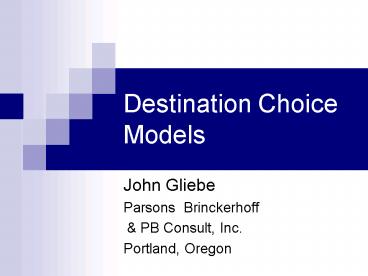Destination Choice Models PowerPoint PPT Presentation
1 / 14
Title: Destination Choice Models
1
Destination Choice Models
- John Gliebe
- Parsons Brinckerhoff
- PB Consult, Inc.
- Portland, Oregon
2
Overview
- Trip distribution in 4-step models
- From gravity model to destination choice model
- Relationship to mode choice modeling
- Anatomy of a destination choice model
- Advantages of destination choice models
- Where destination choice models are used now
3
Why Destination Choice Models?
- More flexible extension of gravity models
- Utility-based interpretation
- Easier to market segment
- Get right workers to the right job locations
- Application is straightforward
4
Trip Generation
- Productions
- Rates estimated from expanded home interview
surveys - Usually cross-classification model of trips
produced by households - e.g. Size X Income X Autos
- Attractions
- Rates estimated from expanded home interview
surveys - e.g. Trip purpose X Attractor Type X Area Type
- Attractors (example)
- employees (retail, non-retail)
- students
- households
5
Trip Distribution in 4-step Model Systems the
Gravity Model
Production-constrained
Attraction-constrained
6
Friction Factors
- Derive a table from observed trip lengths
- or use an assumed impedance function
7
From Gravity Model to Destination Choice Model
8
Link to Mode Choice
Log sums Composite utility of all available
modes for i - j
9
Anatomy of a Destination Choice Model
Introduce market segments m
10
K-factors become interpretable
11
Advantages to Destination Choice Formulation
- Conceptually easier
- Simultaneous consideration of attractions and
impedance - Estimate with disaggregate data
- Transit service improvements reflected in log
sums - Easier to do market segmentation by auto
ownership, and income level - Consistent with Mode Choice logsums
- Interpretation of alternative-specific constants
(replace k-factors) perceived impedance - Get the rights jobs with the right income groups
12
Estimation and Calibration
- Estimate using disaggregate data (household
interview survey) - Sampling used to choose alternate zones
- Calibration--can use employment by zone (or
district) to indicate proportion of HB work trips
by district
13
Examples where applied
- Portland Metro (since 1980s)
- PB work
- Buffalo
- Thurston Co., WA
- Las Vegas
- Salt Lake City (ongoing)
- Los Angeles MTA (ongoing)
- Tour-based Models
- San Francisco CTA
- Columbus
- New York
- Oregon Statewide Model
14
Summary
- Destination Choice models offer a flexible
alternative to Gravity model for trip
distribution. - Provide more informationmore sensitive to policy
analysis - Use readily available data
- Extendable to more sophisticated modeling tasks

